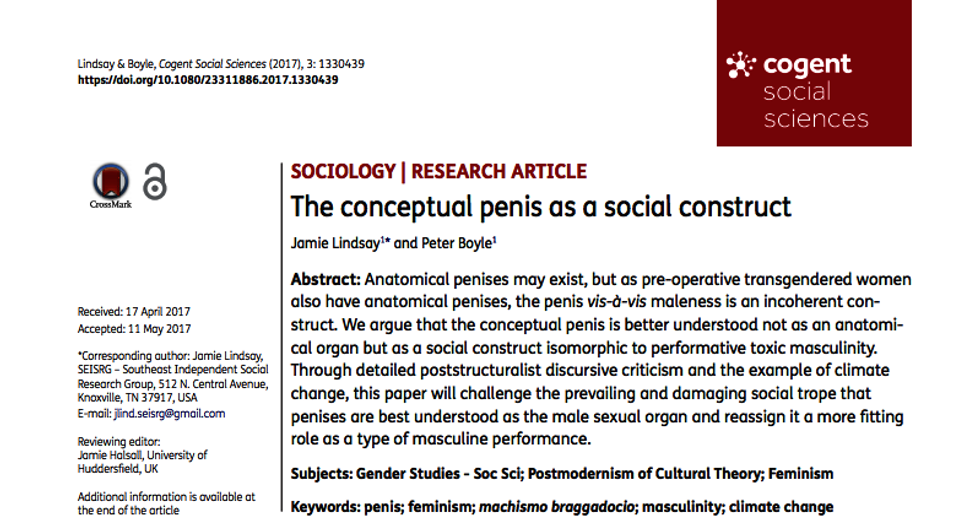
Two academics really hoaxed a peer-reviewed academic journal with hilariously fake paper. (Image source: Getty Creative)

A peer-reviewed academic journal was recently duped in a hilarious way.
Two academics, Peter Boghossian and James Lindsay, recently used pen names to submit an academic paper to a peer-reviewed academic journal to expose the absurdity of modern gender studies by arguing that the male reproductive organ known as the penis is a "social construct."
The 3,000-word paper was titled, "The Conceptual Penis As A Social Construct," and was submitted, and published, to the "Cogent Social Sciences" academic journal in its May edition. Lindsay and Boghossian cited 20 sources in their paper, many of which they said they made up or never read.

"Assuming the pen names 'Jamie Lindsay' and 'Peter Boyle,' and writing for the fictitious 'Southeast Independent Social Research Group,' we wrote an absurd paper loosely composed in the style of post-structuralist discursive gender theory. The paper was ridiculous by intention, essentially arguing that penises shouldn’t be thought of as male genital organs but as damaging social constructions," the duo wrote in a post for Skeptic Magazine, celebrating their hoax.
"We assumed that if we were merely clear in our moral implications that maleness is intrinsically bad and that the penis is somehow at the root of it, we could get the paper published in a respectable journal," they explained.
In fact, the entire point of writing and submitting the paper was to test if a respectable peer-reviewed academic journal is living up to what it should be.
Lindsay and Boghossian explained:
This already damning characterization of our hoax understates our paper’s lack of fitness for academic publication by orders of magnitude. We didn’t try to make the paper coherent; instead, we stuffed it full of jargon (like “discursive” and “isomorphism”), nonsense (like arguing that hypermasculine men are both inside and outside of certain discourses at the same time), red-flag phrases (like “pre-post-patriarchal society”), lewd references to slang terms for the penis, insulting phrasing regarding men (including referring to some men who choose not to have children as being “unable to coerce a mate”), and allusions to rape (we stated that “manspreading,” a complaint levied against men for sitting with their legs spread wide, is “akin to raping the empty space around him”). After completing the paper, we read it carefully to ensure it didn’t say anything meaningful, and as neither one of us could determine what it is actually about, we deemed it a success.
They even made sure they used enough liberal, anti-male jargon to ensure the journal's editors loved it:
We intended to test the hypothesis that flattery of the academic Left’s moral architecture in general, and of the moral orthodoxy in gender studies in particular, is the overwhelming determiner of publication in an academic journal in the field. That is, we sought to demonstrate that a desire for a certain moral view of the world to be validated could overcome the critical assessment required for legitimate scholarship. Particularly, we suspected that gender studies is crippled academically by an overriding almost-religious belief that maleness is the root of all evil. On the evidence, our suspicion was justified.
In the paper, the duo argued that the "conceptual penis" and "hypermasculine dominance" causes climate change — a conclusion the likely progressive academic reviewers probably applauded.
They wrote in the paper:
Nowhere are the consequences of hypermasculine machismo braggadocio isomorphic identification with the conceptual penis more problematic than concerning the issue of climate change. Climate change is driven by nothing more than it is by certain damaging themes in hypermasculinity that can be best understood via the dominant rapacious approach to climate ecology identifiable with the conceptual penis. Our planet is rapidly approaching the much-warned-about 2°C climate change threshold, and due to patriarchal power dynamics that maintain present capitalist structures, especially with regard to the fossil fuel industry, the connection between hypermasculine dominance of scientific, political, and economic discourses and the irreparable damage to our ecosystem is made clear.
Indeed, according to the academics, the editors of the journal loved their conclusion that penises "are not best understood as the male sexual organ" but rather "social construct that is both damaging and problematic for society and future generations."
In the end, the duo said their paper "was rooted in moral and political biases masquerading as rigorous academic theory. Working in a biased environment, we successfully sugarcoated utter nonsense with a combination of fashionable moral sentiments and impenetrable jargon."
"Cogent Social Sciences happily swallowed the pill. It left utter nonsense easy to disguise," they explained.
They concluded: "'The Conceptual Penis as a Social Construct' should not have been published on its merits because it was actively written to avoid having any merits whatsoever. The paper is academically worthless nonsense. The question that now needs to be answered is, 'How can we restore the reliability of the peer-review process?'"